Essay on Workplace Aggression, Bullying, and Incivility
VerifiedAdded on 2022/08/19
|6
|1293
|14
Essay
AI Summary
This essay examines the concepts of workplace aggression, bullying, and incivility, drawing on three scholarly articles. It analyzes the purpose, hypotheses, methodologies, and findings of each study, including Andersson and Pearson's (1999) research on incivility, Escartin et al.'s (2009) study on bullying severity, and Barling, Dupré, and Kelloway's (2009) work on workplace violence myths. The essay identifies strengths and weaknesses of each study, suggests directions for future research, and discusses practical implications for organizations. It emphasizes the negative impacts of workplace incivility and violence, and the need for proactive policies and employee training to mitigate these issues. The essay concludes by highlighting the overlap between bullying and incivility, and the importance of addressing these behaviors to foster a healthier work environment.
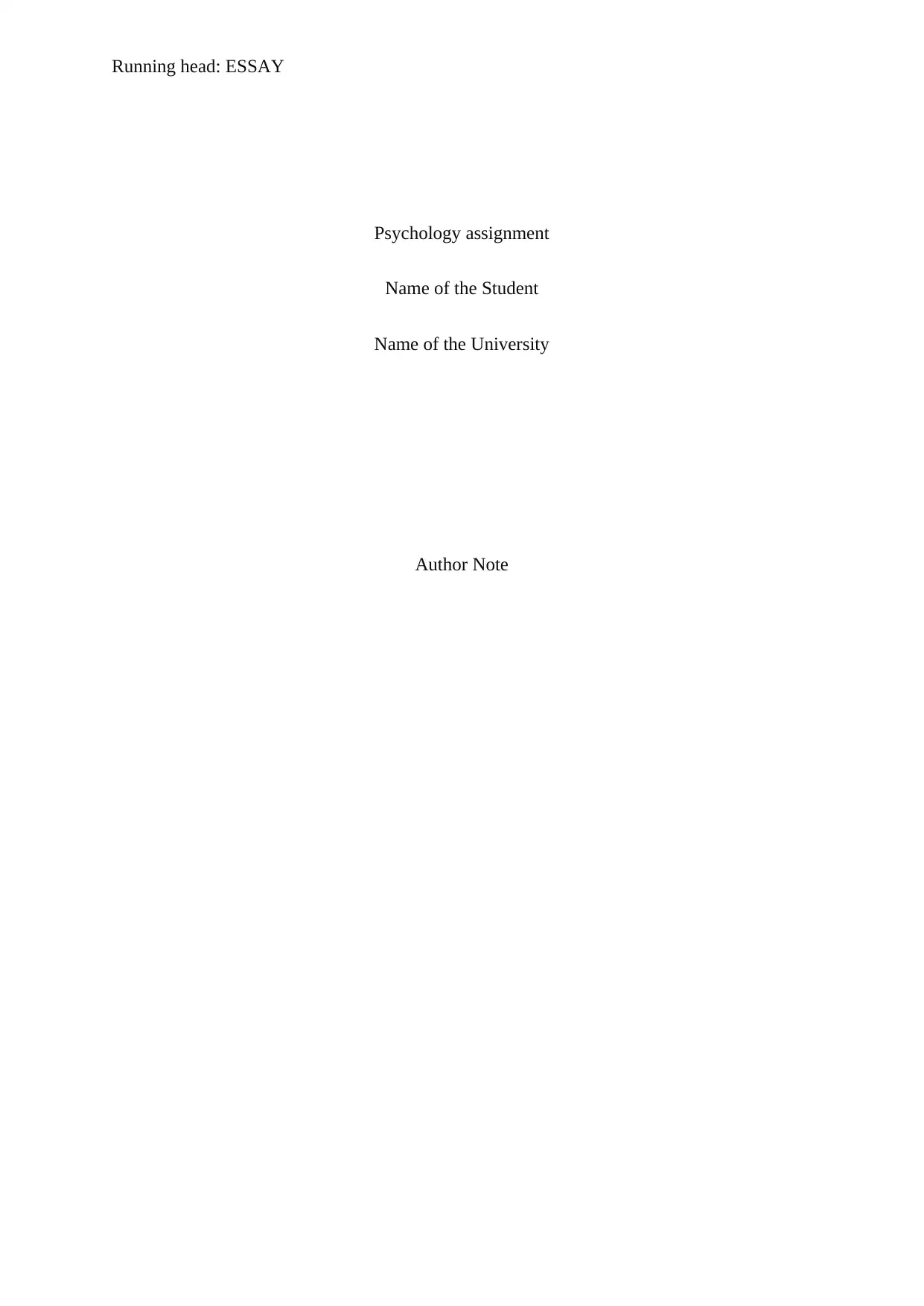
Running head: ESSAY
Psychology assignment
Name of the Student
Name of the University
Author Note
Psychology assignment
Name of the Student
Name of the University
Author Note
Paraphrase This Document
Need a fresh take? Get an instant paraphrase of this document with our AI Paraphraser
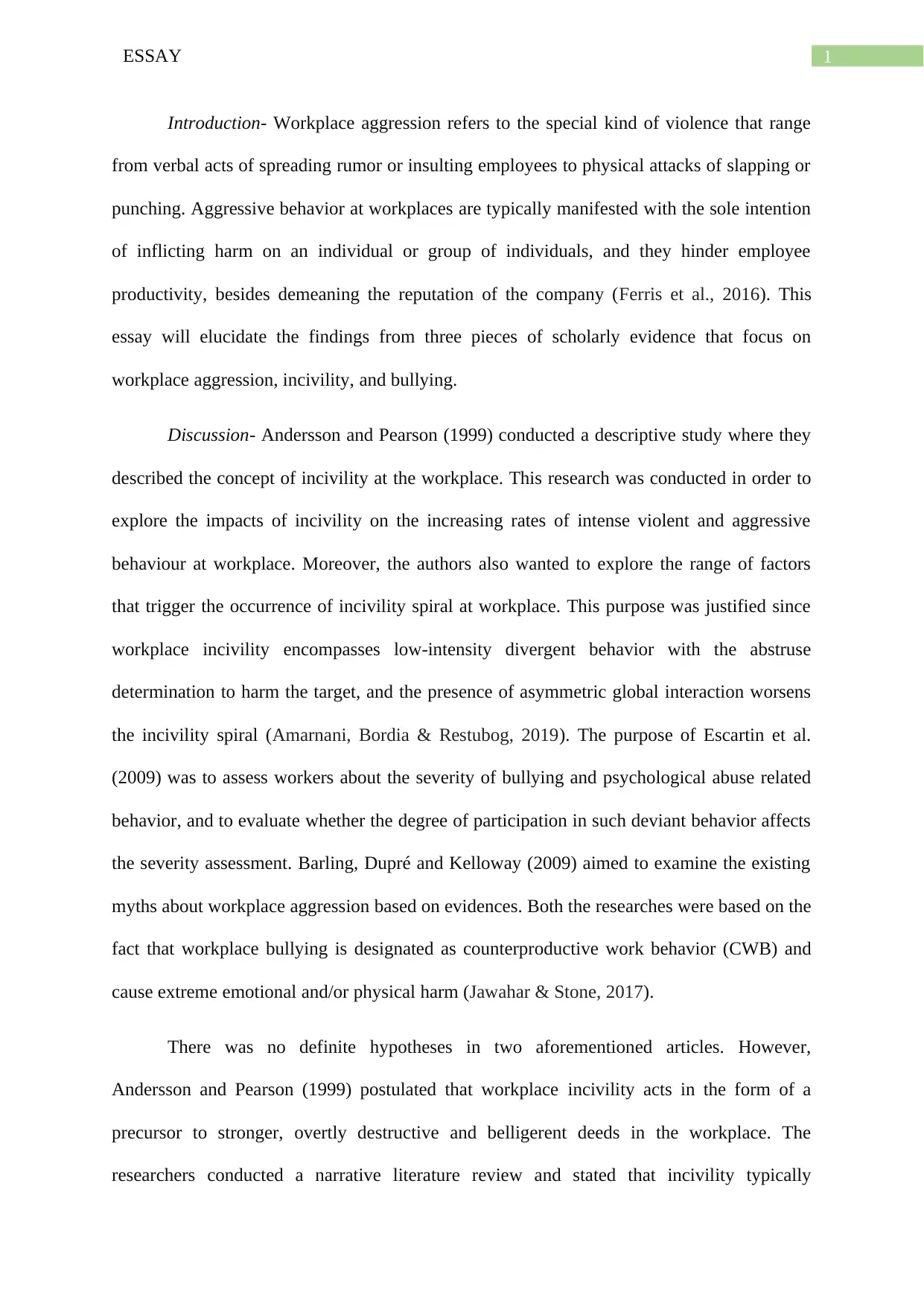
1ESSAY
Introduction- Workplace aggression refers to the special kind of violence that range
from verbal acts of spreading rumor or insulting employees to physical attacks of slapping or
punching. Aggressive behavior at workplaces are typically manifested with the sole intention
of inflicting harm on an individual or group of individuals, and they hinder employee
productivity, besides demeaning the reputation of the company (Ferris et al., 2016). This
essay will elucidate the findings from three pieces of scholarly evidence that focus on
workplace aggression, incivility, and bullying.
Discussion- Andersson and Pearson (1999) conducted a descriptive study where they
described the concept of incivility at the workplace. This research was conducted in order to
explore the impacts of incivility on the increasing rates of intense violent and aggressive
behaviour at workplace. Moreover, the authors also wanted to explore the range of factors
that trigger the occurrence of incivility spiral at workplace. This purpose was justified since
workplace incivility encompasses low-intensity divergent behavior with the abstruse
determination to harm the target, and the presence of asymmetric global interaction worsens
the incivility spiral (Amarnani, Bordia & Restubog, 2019). The purpose of Escartin et al.
(2009) was to assess workers about the severity of bullying and psychological abuse related
behavior, and to evaluate whether the degree of participation in such deviant behavior affects
the severity assessment. Barling, Dupré and Kelloway (2009) aimed to examine the existing
myths about workplace aggression based on evidences. Both the researches were based on the
fact that workplace bullying is designated as counterproductive work behavior (CWB) and
cause extreme emotional and/or physical harm (Jawahar & Stone, 2017).
There was no definite hypotheses in two aforementioned articles. However,
Andersson and Pearson (1999) postulated that workplace incivility acts in the form of a
precursor to stronger, overtly destructive and belligerent deeds in the workplace. The
researchers conducted a narrative literature review and stated that incivility typically
Introduction- Workplace aggression refers to the special kind of violence that range
from verbal acts of spreading rumor or insulting employees to physical attacks of slapping or
punching. Aggressive behavior at workplaces are typically manifested with the sole intention
of inflicting harm on an individual or group of individuals, and they hinder employee
productivity, besides demeaning the reputation of the company (Ferris et al., 2016). This
essay will elucidate the findings from three pieces of scholarly evidence that focus on
workplace aggression, incivility, and bullying.
Discussion- Andersson and Pearson (1999) conducted a descriptive study where they
described the concept of incivility at the workplace. This research was conducted in order to
explore the impacts of incivility on the increasing rates of intense violent and aggressive
behaviour at workplace. Moreover, the authors also wanted to explore the range of factors
that trigger the occurrence of incivility spiral at workplace. This purpose was justified since
workplace incivility encompasses low-intensity divergent behavior with the abstruse
determination to harm the target, and the presence of asymmetric global interaction worsens
the incivility spiral (Amarnani, Bordia & Restubog, 2019). The purpose of Escartin et al.
(2009) was to assess workers about the severity of bullying and psychological abuse related
behavior, and to evaluate whether the degree of participation in such deviant behavior affects
the severity assessment. Barling, Dupré and Kelloway (2009) aimed to examine the existing
myths about workplace aggression based on evidences. Both the researches were based on the
fact that workplace bullying is designated as counterproductive work behavior (CWB) and
cause extreme emotional and/or physical harm (Jawahar & Stone, 2017).
There was no definite hypotheses in two aforementioned articles. However,
Andersson and Pearson (1999) postulated that workplace incivility acts in the form of a
precursor to stronger, overtly destructive and belligerent deeds in the workplace. The
researchers conducted a narrative literature review and stated that incivility typically
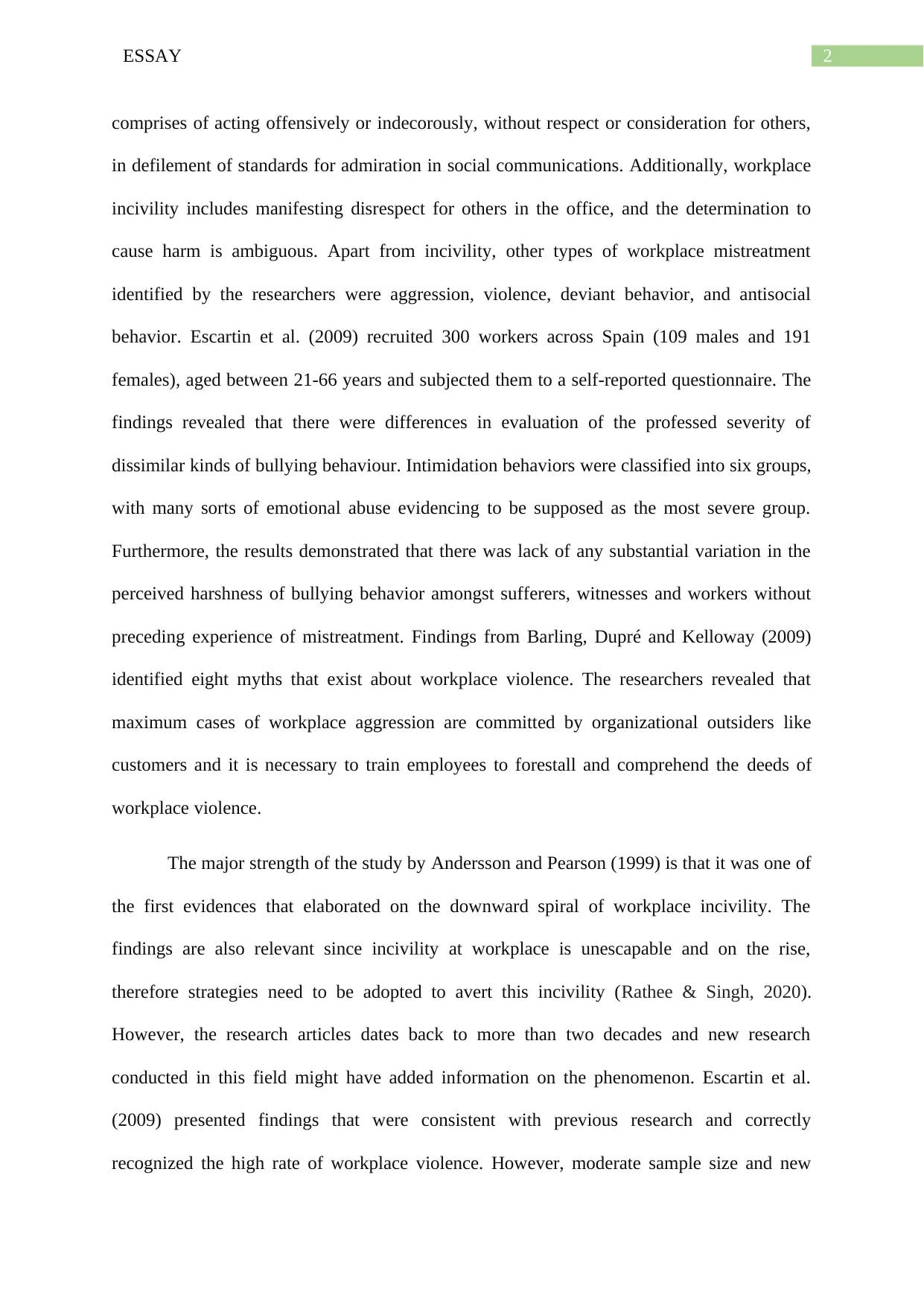
2ESSAY
comprises of acting offensively or indecorously, without respect or consideration for others,
in defilement of standards for admiration in social communications. Additionally, workplace
incivility includes manifesting disrespect for others in the office, and the determination to
cause harm is ambiguous. Apart from incivility, other types of workplace mistreatment
identified by the researchers were aggression, violence, deviant behavior, and antisocial
behavior. Escartin et al. (2009) recruited 300 workers across Spain (109 males and 191
females), aged between 21-66 years and subjected them to a self-reported questionnaire. The
findings revealed that there were differences in evaluation of the professed severity of
dissimilar kinds of bullying behaviour. Intimidation behaviors were classified into six groups,
with many sorts of emotional abuse evidencing to be supposed as the most severe group.
Furthermore, the results demonstrated that there was lack of any substantial variation in the
perceived harshness of bullying behavior amongst sufferers, witnesses and workers without
preceding experience of mistreatment. Findings from Barling, Dupré and Kelloway (2009)
identified eight myths that exist about workplace violence. The researchers revealed that
maximum cases of workplace aggression are committed by organizational outsiders like
customers and it is necessary to train employees to forestall and comprehend the deeds of
workplace violence.
The major strength of the study by Andersson and Pearson (1999) is that it was one of
the first evidences that elaborated on the downward spiral of workplace incivility. The
findings are also relevant since incivility at workplace is unescapable and on the rise,
therefore strategies need to be adopted to avert this incivility (Rathee & Singh, 2020).
However, the research articles dates back to more than two decades and new research
conducted in this field might have added information on the phenomenon. Escartin et al.
(2009) presented findings that were consistent with previous research and correctly
recognized the high rate of workplace violence. However, moderate sample size and new
comprises of acting offensively or indecorously, without respect or consideration for others,
in defilement of standards for admiration in social communications. Additionally, workplace
incivility includes manifesting disrespect for others in the office, and the determination to
cause harm is ambiguous. Apart from incivility, other types of workplace mistreatment
identified by the researchers were aggression, violence, deviant behavior, and antisocial
behavior. Escartin et al. (2009) recruited 300 workers across Spain (109 males and 191
females), aged between 21-66 years and subjected them to a self-reported questionnaire. The
findings revealed that there were differences in evaluation of the professed severity of
dissimilar kinds of bullying behaviour. Intimidation behaviors were classified into six groups,
with many sorts of emotional abuse evidencing to be supposed as the most severe group.
Furthermore, the results demonstrated that there was lack of any substantial variation in the
perceived harshness of bullying behavior amongst sufferers, witnesses and workers without
preceding experience of mistreatment. Findings from Barling, Dupré and Kelloway (2009)
identified eight myths that exist about workplace violence. The researchers revealed that
maximum cases of workplace aggression are committed by organizational outsiders like
customers and it is necessary to train employees to forestall and comprehend the deeds of
workplace violence.
The major strength of the study by Andersson and Pearson (1999) is that it was one of
the first evidences that elaborated on the downward spiral of workplace incivility. The
findings are also relevant since incivility at workplace is unescapable and on the rise,
therefore strategies need to be adopted to avert this incivility (Rathee & Singh, 2020).
However, the research articles dates back to more than two decades and new research
conducted in this field might have added information on the phenomenon. Escartin et al.
(2009) presented findings that were consistent with previous research and correctly
recognized the high rate of workplace violence. However, moderate sample size and new
⊘ This is a preview!⊘
Do you want full access?
Subscribe today to unlock all pages.

Trusted by 1+ million students worldwide
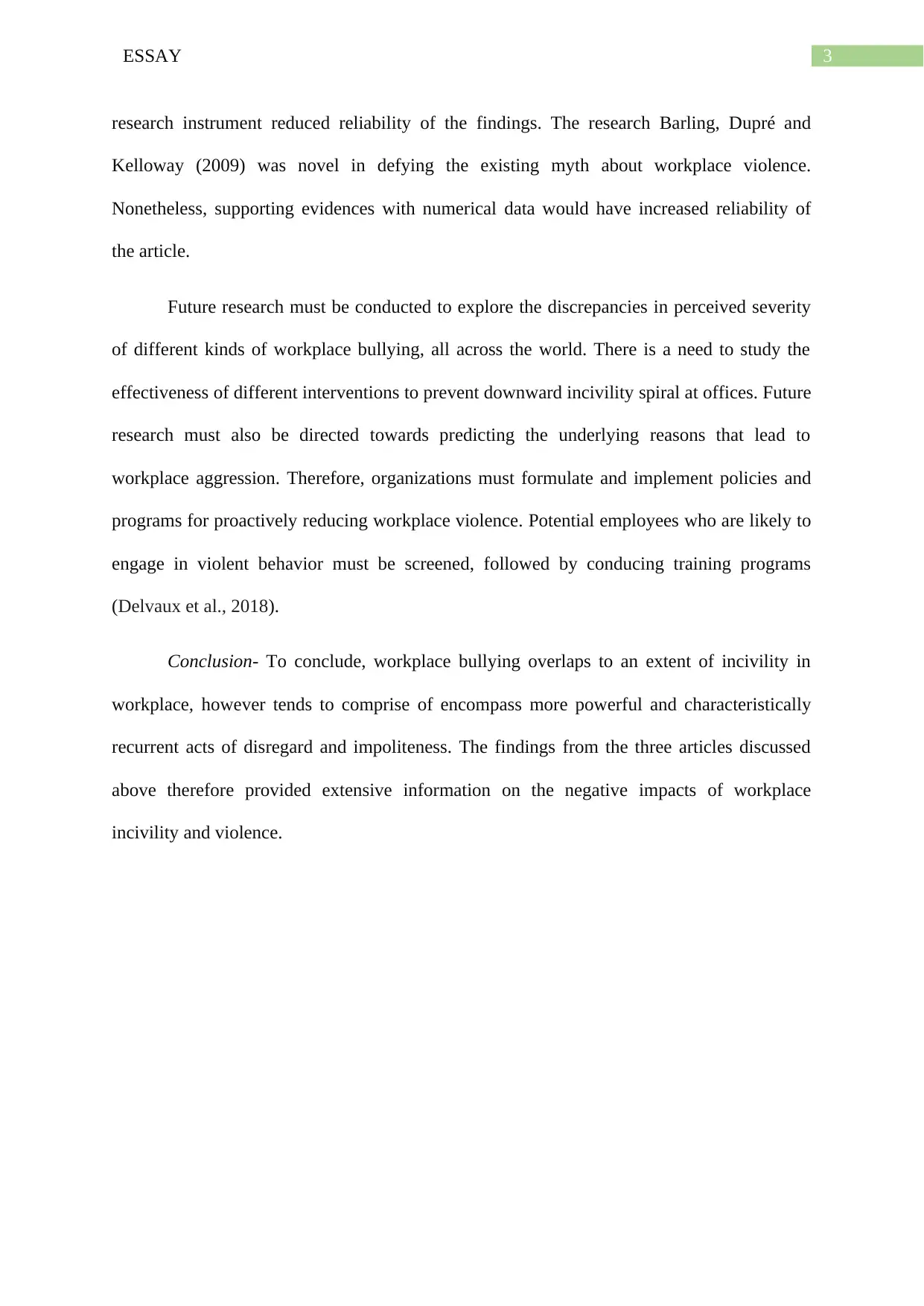
3ESSAY
research instrument reduced reliability of the findings. The research Barling, Dupré and
Kelloway (2009) was novel in defying the existing myth about workplace violence.
Nonetheless, supporting evidences with numerical data would have increased reliability of
the article.
Future research must be conducted to explore the discrepancies in perceived severity
of different kinds of workplace bullying, all across the world. There is a need to study the
effectiveness of different interventions to prevent downward incivility spiral at offices. Future
research must also be directed towards predicting the underlying reasons that lead to
workplace aggression. Therefore, organizations must formulate and implement policies and
programs for proactively reducing workplace violence. Potential employees who are likely to
engage in violent behavior must be screened, followed by conducing training programs
(Delvaux et al., 2018).
Conclusion- To conclude, workplace bullying overlaps to an extent of incivility in
workplace, however tends to comprise of encompass more powerful and characteristically
recurrent acts of disregard and impoliteness. The findings from the three articles discussed
above therefore provided extensive information on the negative impacts of workplace
incivility and violence.
research instrument reduced reliability of the findings. The research Barling, Dupré and
Kelloway (2009) was novel in defying the existing myth about workplace violence.
Nonetheless, supporting evidences with numerical data would have increased reliability of
the article.
Future research must be conducted to explore the discrepancies in perceived severity
of different kinds of workplace bullying, all across the world. There is a need to study the
effectiveness of different interventions to prevent downward incivility spiral at offices. Future
research must also be directed towards predicting the underlying reasons that lead to
workplace aggression. Therefore, organizations must formulate and implement policies and
programs for proactively reducing workplace violence. Potential employees who are likely to
engage in violent behavior must be screened, followed by conducing training programs
(Delvaux et al., 2018).
Conclusion- To conclude, workplace bullying overlaps to an extent of incivility in
workplace, however tends to comprise of encompass more powerful and characteristically
recurrent acts of disregard and impoliteness. The findings from the three articles discussed
above therefore provided extensive information on the negative impacts of workplace
incivility and violence.
Paraphrase This Document
Need a fresh take? Get an instant paraphrase of this document with our AI Paraphraser
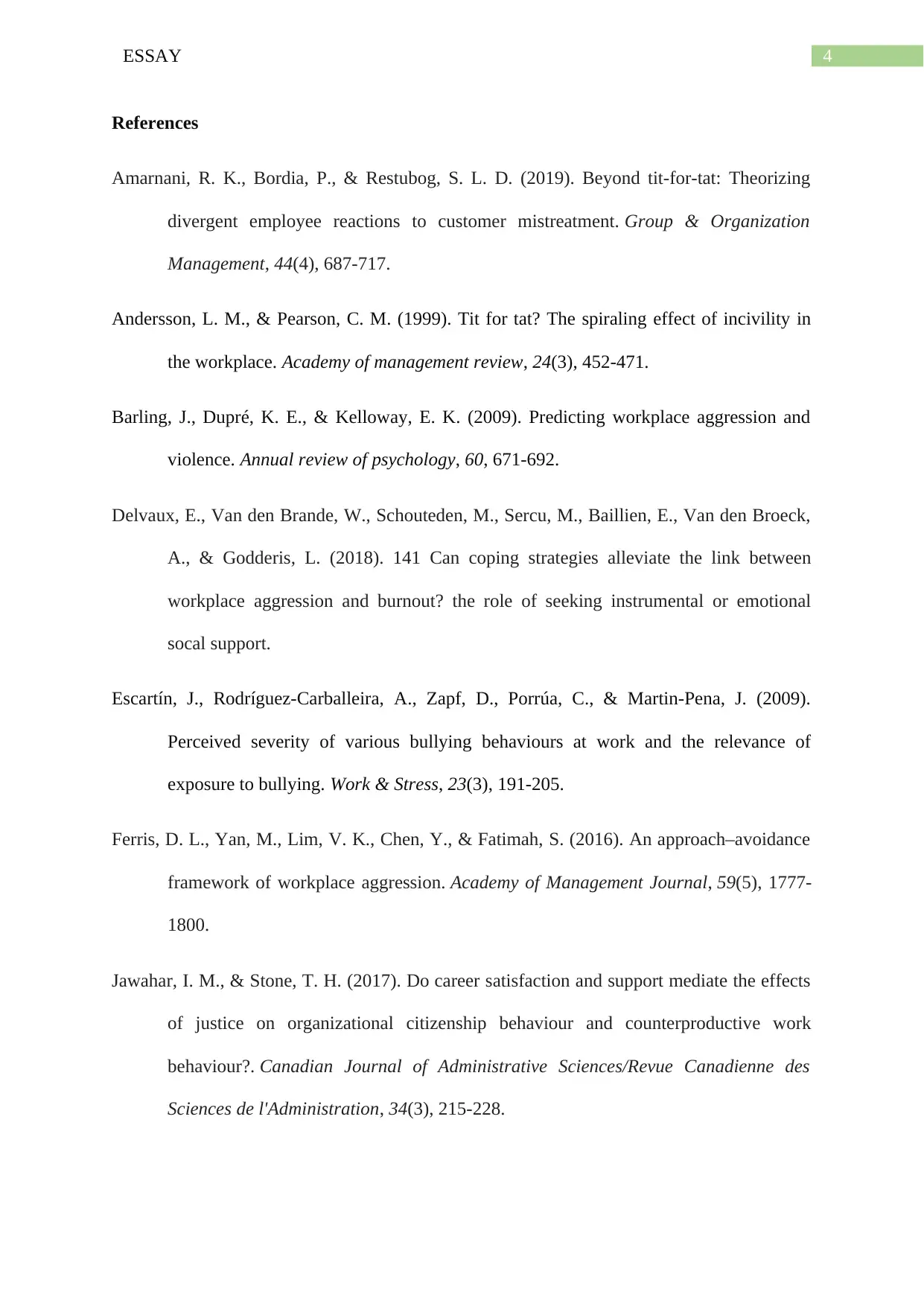
4ESSAY
References
Amarnani, R. K., Bordia, P., & Restubog, S. L. D. (2019). Beyond tit-for-tat: Theorizing
divergent employee reactions to customer mistreatment. Group & Organization
Management, 44(4), 687-717.
Andersson, L. M., & Pearson, C. M. (1999). Tit for tat? The spiraling effect of incivility in
the workplace. Academy of management review, 24(3), 452-471.
Barling, J., Dupré, K. E., & Kelloway, E. K. (2009). Predicting workplace aggression and
violence. Annual review of psychology, 60, 671-692.
Delvaux, E., Van den Brande, W., Schouteden, M., Sercu, M., Baillien, E., Van den Broeck,
A., & Godderis, L. (2018). 141 Can coping strategies alleviate the link between
workplace aggression and burnout? the role of seeking instrumental or emotional
socal support.
Escartín, J., Rodríguez-Carballeira, A., Zapf, D., Porrúa, C., & Martin-Pena, J. (2009).
Perceived severity of various bullying behaviours at work and the relevance of
exposure to bullying. Work & Stress, 23(3), 191-205.
Ferris, D. L., Yan, M., Lim, V. K., Chen, Y., & Fatimah, S. (2016). An approach–avoidance
framework of workplace aggression. Academy of Management Journal, 59(5), 1777-
1800.
Jawahar, I. M., & Stone, T. H. (2017). Do career satisfaction and support mediate the effects
of justice on organizational citizenship behaviour and counterproductive work
behaviour?. Canadian Journal of Administrative Sciences/Revue Canadienne des
Sciences de l'Administration, 34(3), 215-228.
References
Amarnani, R. K., Bordia, P., & Restubog, S. L. D. (2019). Beyond tit-for-tat: Theorizing
divergent employee reactions to customer mistreatment. Group & Organization
Management, 44(4), 687-717.
Andersson, L. M., & Pearson, C. M. (1999). Tit for tat? The spiraling effect of incivility in
the workplace. Academy of management review, 24(3), 452-471.
Barling, J., Dupré, K. E., & Kelloway, E. K. (2009). Predicting workplace aggression and
violence. Annual review of psychology, 60, 671-692.
Delvaux, E., Van den Brande, W., Schouteden, M., Sercu, M., Baillien, E., Van den Broeck,
A., & Godderis, L. (2018). 141 Can coping strategies alleviate the link between
workplace aggression and burnout? the role of seeking instrumental or emotional
socal support.
Escartín, J., Rodríguez-Carballeira, A., Zapf, D., Porrúa, C., & Martin-Pena, J. (2009).
Perceived severity of various bullying behaviours at work and the relevance of
exposure to bullying. Work & Stress, 23(3), 191-205.
Ferris, D. L., Yan, M., Lim, V. K., Chen, Y., & Fatimah, S. (2016). An approach–avoidance
framework of workplace aggression. Academy of Management Journal, 59(5), 1777-
1800.
Jawahar, I. M., & Stone, T. H. (2017). Do career satisfaction and support mediate the effects
of justice on organizational citizenship behaviour and counterproductive work
behaviour?. Canadian Journal of Administrative Sciences/Revue Canadienne des
Sciences de l'Administration, 34(3), 215-228.
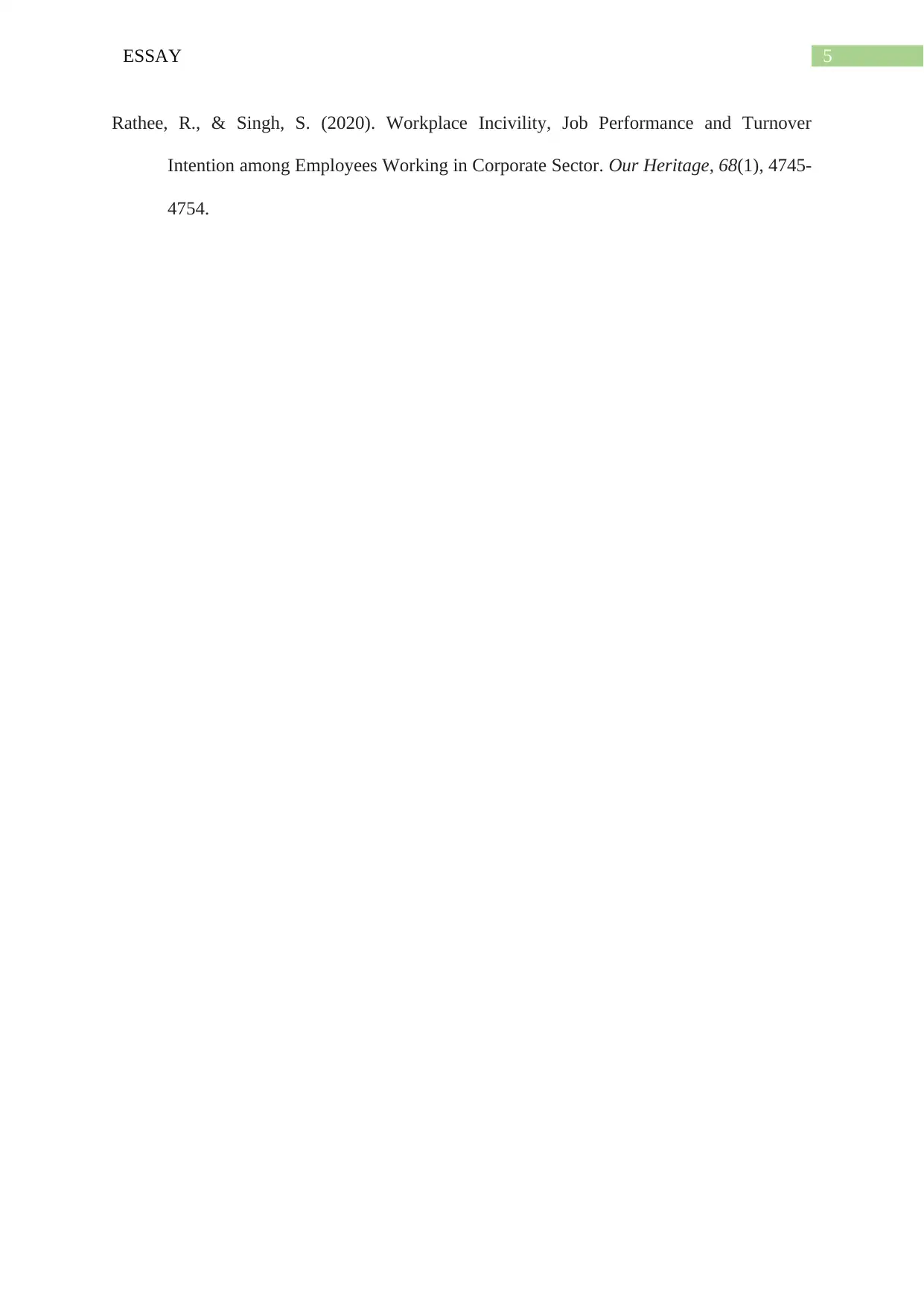
5ESSAY
Rathee, R., & Singh, S. (2020). Workplace Incivility, Job Performance and Turnover
Intention among Employees Working in Corporate Sector. Our Heritage, 68(1), 4745-
4754.
Rathee, R., & Singh, S. (2020). Workplace Incivility, Job Performance and Turnover
Intention among Employees Working in Corporate Sector. Our Heritage, 68(1), 4745-
4754.
⊘ This is a preview!⊘
Do you want full access?
Subscribe today to unlock all pages.

Trusted by 1+ million students worldwide
1 out of 6
Your All-in-One AI-Powered Toolkit for Academic Success.
+13062052269
info@desklib.com
Available 24*7 on WhatsApp / Email
![[object Object]](/_next/static/media/star-bottom.7253800d.svg)
Unlock your academic potential
Copyright © 2020–2025 A2Z Services. All Rights Reserved. Developed and managed by ZUCOL.
